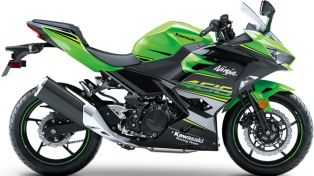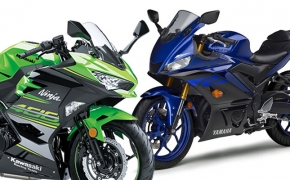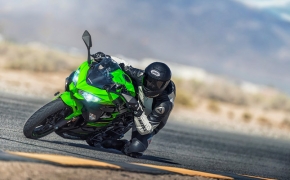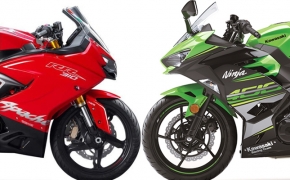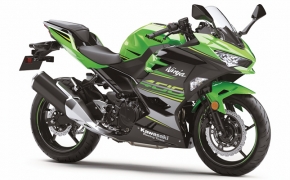No longer was Kawasaki going to keep taking it from the KTM who in the recent years have taken the sole responsibility of raising 300cc class engines. Kawasaki has dealt a strong and big hand to the Austrian manufacturers this time with the all-new 2018 Ninja 400. The bike sports a 399cc engine, biggest in its class and H2 inspired design which is the meanest bike across every class. The bike was unveiled in Tokyo motor show 2018 held in Japan and was also accompanied by its small brother Ninja 250.
Design and Style:
Kawasaki left no stone unturned in making this bike look its best. To be honest Ninja 400 looks more like a toned down Ninja H2 than any other bike in ninja series. One can easily spot the design updates like the tail cowl, swing arm-mounting plate make it feel naturally related to the supercharged H2. Unlike the Z900, Z650 and H2, there is no frame bar sticking out of its cowl instead it takes styling cues for its fuel tank from the middleweight Ninja 650.
The headlight is also “H2-inspired” with the front of headlight housing two lights in each socket, instead of just one in the middle and in the black colour it truly looks like a blue-eyed real life Ninja stalking you in the dark but no intake vents. Ultra-light trellis frame also makes its debut this low down in the engine range. You can read all about the trellis frame here, but just a quick fact. This frame is being used in bikes across categories. Be it the naked roadster KTM Duke 390 or middleweight cruiser Honda Rebel 500.
Aesthetics and Protrusions:
With the thought of dominating the 400 cc class, Ninja 400 loses 2 pounds and gains ABS and Slipper & assist clutch as standard. Making the bike stand straight is the responsibility of beefed up front forks which is 4 mm fatter from the last time. Seat height is the same as 785 mm but with better cushioning. An LCD panel can be found on the console with a gear position indicator. Handlebars, though predominantly clip-on but they are slightly raised for ease of touring long distances, which is what many of us will be using this bike for anyways but the seating position will be aggressive for all intents and purposes.
Engine and Performance:
Powering the small Hulk is the all-new 399 CC DOHC fuel injected parallel twin generating 45 Horses at 10,000 RPM and 38 NM of pull at 8,000 RPM. Comparing with other bad boys, The KTM RC 390 produces 40 HP at 9,000 RPM and 36 Nm @ 7,000 RPM with Yamaha currently sporting the most muscle at 42 HP @ 10750 and a torque of 29.6 Nm hitting late at 9,000 RPM. A higher compression ratio of 11:5:1 (earlier 10.6:1) provides better combustion bore and stroke is 70 X 51.8 mm (earlier 62 X 49), which will ensure usable power in the top of the RPM range. All this mated to a 6-speed gearbox on a bike with a curb weight of 168 kg.
Needless to say Kawasaki easily “Smashes” the competition in terms of Engine specs. A single 290 mm petal disc with a dual piston at the front provides heat dissipation from the massive inevitable bite which it will offer and a similar petal disc of 220 mm at the back with the dual piston as well, do the same. The front suspension isn’t adjustable at all and the rear is adjustable only for pre-load, But if you want one setting for the road and the track. There isn’t much to adjust.
Up and above:
The Power hits at 10,000 RPM which is a 1,000 early than the Ninja 300 but 6 HP less. This boils down to a lot of power which hits quickly, but it’s still late than the competition. With modifications in the World Supersport 300 series, which now allows 300-500 cc engine range, the Ninja 400 already seems like a popular choice with its low weight and the ability to rev higher for longer.
One more point which distinguishes Ninja 400 is the official range of modifications available from the Kawasaki including tank bangs, frame sliders, windshields and even a titanium Akrapovic exhaust.
Final thoughts:
Kawasaki has made this bike brilliantly; they have put everything into a package and have even succeeded at keeping that package small and compact. After everything said and analyzed it all comes down to the pricing. KTM RC 390 goes out of the showroom at Rs 2.25 lakh and on the road at 2.60 lakh. The Ninja 400 is priced at Rs 4, 69,000 (Ex-Showroom) which is twice the amount for 5 more horses and an additional cylinder. If Kawasaki can work its magic in the price figures just like they did with this bike, then we believe that all of us will be looking at a new “Green evolution”.
Design and Style:
Kawasaki left no stone unturned in making this bike look its best. To be honest Ninja 400 looks more like a toned down Ninja H2 than any other bike in ninja series. One can easily spot the design updates like the tail cowl, swing arm-mounting plate make it feel naturally related to the supercharged H2. Unlike the Z900, Z650 and H2, there is no frame bar sticking out of its cowl instead it takes styling cues for its fuel tank from the middleweight Ninja 650.
The headlight is also “H2-inspired” with the front of headlight housing two lights in each socket, instead of just one in the middle and in the black colour it truly looks like a blue-eyed real life Ninja stalking you in the dark but no intake vents. Ultra-light trellis frame also makes its debut this low down in the engine range. You can read all about the trellis frame here, but just a quick fact. This frame is being used in bikes across categories. Be it the naked roadster KTM Duke 390 or middleweight cruiser Honda Rebel 500.
Aesthetics and Protrusions:
With the thought of dominating the 400 cc class, Ninja 400 loses 2 pounds and gains ABS and Slipper & assist clutch as standard. Making the bike stand straight is the responsibility of beefed up front forks which is 4 mm fatter from the last time. Seat height is the same as 785 mm but with better cushioning. An LCD panel can be found on the console with a gear position indicator. Handlebars, though predominantly clip-on but they are slightly raised for ease of touring long distances, which is what many of us will be using this bike for anyways but the seating position will be aggressive for all intents and purposes.
Engine and Performance:
Powering the small Hulk is the all-new 399 CC DOHC fuel injected parallel twin generating 45 Horses at 10,000 RPM and 38 NM of pull at 8,000 RPM. Comparing with other bad boys, The KTM RC 390 produces 40 HP at 9,000 RPM and 36 Nm @ 7,000 RPM with Yamaha currently sporting the most muscle at 42 HP @ 10750 and a torque of 29.6 Nm hitting late at 9,000 RPM. A higher compression ratio of 11:5:1 (earlier 10.6:1) provides better combustion bore and stroke is 70 X 51.8 mm (earlier 62 X 49), which will ensure usable power in the top of the RPM range. All this mated to a 6-speed gearbox on a bike with a curb weight of 168 kg.
Needless to say Kawasaki easily “Smashes” the competition in terms of Engine specs. A single 290 mm petal disc with a dual piston at the front provides heat dissipation from the massive inevitable bite which it will offer and a similar petal disc of 220 mm at the back with the dual piston as well, do the same. The front suspension isn’t adjustable at all and the rear is adjustable only for pre-load, But if you want one setting for the road and the track. There isn’t much to adjust.
Up and above:
The Power hits at 10,000 RPM which is a 1,000 early than the Ninja 300 but 6 HP less. This boils down to a lot of power which hits quickly, but it’s still late than the competition. With modifications in the World Supersport 300 series, which now allows 300-500 cc engine range, the Ninja 400 already seems like a popular choice with its low weight and the ability to rev higher for longer.
One more point which distinguishes Ninja 400 is the official range of modifications available from the Kawasaki including tank bangs, frame sliders, windshields and even a titanium Akrapovic exhaust.
Final thoughts:
Kawasaki has made this bike brilliantly; they have put everything into a package and have even succeeded at keeping that package small and compact. After everything said and analyzed it all comes down to the pricing. KTM RC 390 goes out of the showroom at Rs 2.25 lakh and on the road at 2.60 lakh. The Ninja 400 is priced at Rs 4, 69,000 (Ex-Showroom) which is twice the amount for 5 more horses and an additional cylinder. If Kawasaki can work its magic in the price figures just like they did with this bike, then we believe that all of us will be looking at a new “Green evolution”.












